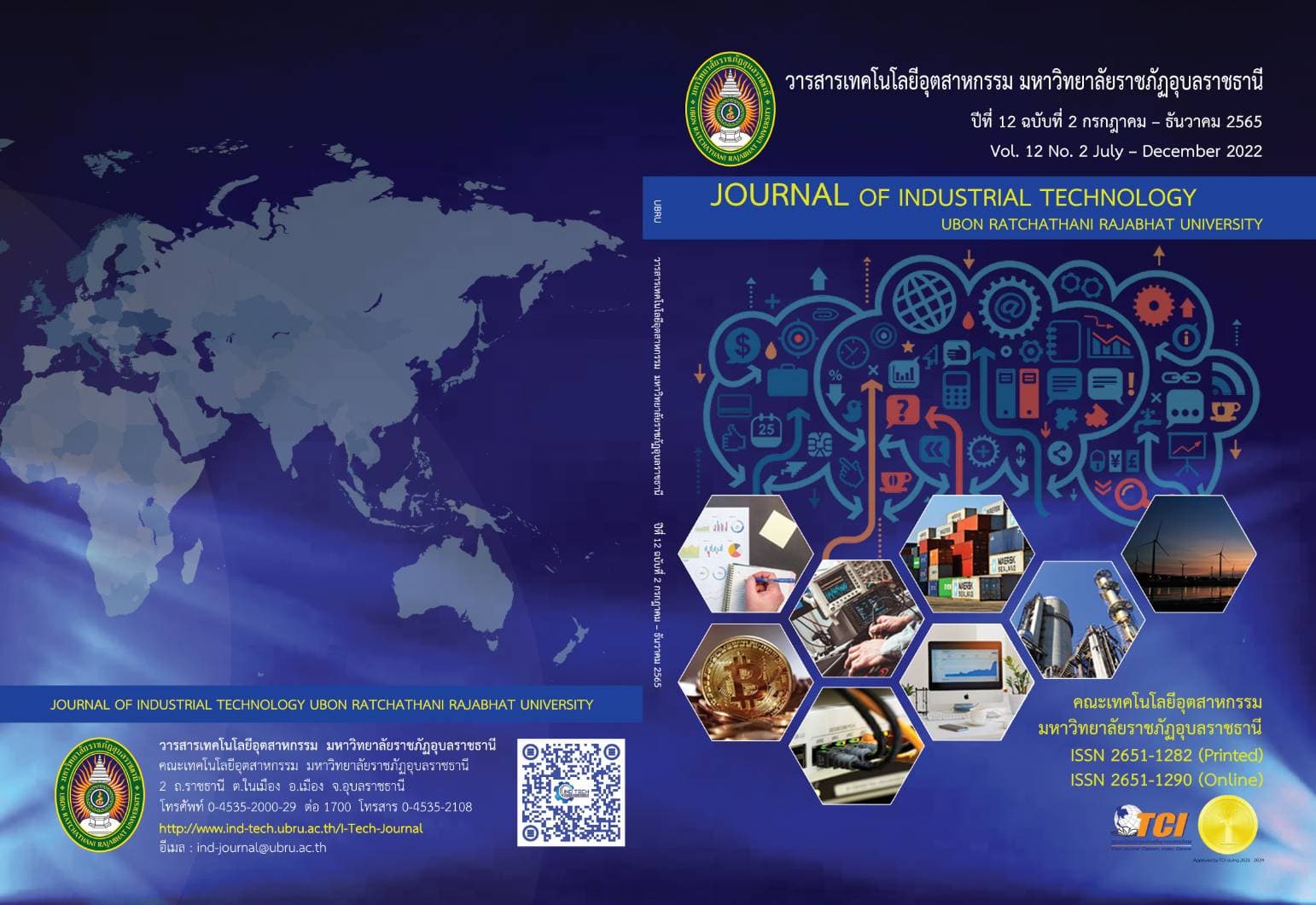การศึกษาระบบปล่องลมแสงอาทิตย์ในการผลิตกระแสไฟฟ้าบนพื้นดาดฟ้าอาคารสูง
Main Article Content
บทคัดย่อ
งานวิจัยนี้มีวัตถุประสงค์เพื่อมุ่งทำการศึกษาระบบปล่องลมแสงอาทิตย์บนพื้นดาดฟ้าอาคารสูงซึ่งสามารถนำพลังงานลมและแสงอาทิตย์มาใช้ประโยชน์ด้วยการผลิตเป็นกระแสไฟฟ้า โดยมีหลักการทำงาน คือ พลังงานจากความแตกต่างของอุณหภูมิภายในระบบปล่องลมแสงอาทิตย์ทำให้เกิดการเคลื่อนที่ของลมร้อนภายในปล่องลมเพื่อขับใบพัดลมและเครื่องกำเนิดไฟฟ้ากระแสตรงให้เกิดแรงเคลื่อนไฟฟ้าออกมาใช้งาน ซึ่งมีส่วนประกอบหลัก คือ อุปกรณ์สะสมความร้อนภายในปล่องลม ใบพัดลมและชุดกำเนิดไฟฟ้ากระแสตรง การดำเนินงานวิจัยถูกแบ่งออกเป็น 2 การทดลอง การทดลองแรกเป็นการศึกษาเปรียบเทียบอุณหภูมิที่ตำแหน่งต่าง ๆ ภายในปล่องลมโดยทดลองกับวัสดุพื้นผิวสะสมความร้อน 2 ชนิด คือ แผ่นเหล็กดำกับยางมะตอย และการทดลองที่สองเป็นการศึกษาเปรียบเทียบผลของการวัดปริมาณกระแสไฟฟ้าที่ผลิตได้ ผลจากการทดลองพบว่า ตำแหน่งของการวัดที่แตกต่างกันมีผลต่ออุณหภูมิที่เกิดขึ้นภายในระบบอย่างมีนัยสำคัญ โดยตำแหน่ง P2 ซึ่งเป็นตำแหน่งที่ถูกติดตั้งอยู่บริเวณฐานปล่องลมนั้นเป็นตำแหน่งที่ให้อุณหภูมิสูงสุด โดยวัสดุพื้นผิวที่เป็นแผ่นเหล็กดำสามารถเก็บสะสมความร้อนและให้พลังงานไฟฟ้าสูงกว่าวัสดุพื้นผิวยางมะตอย นอกจากนี้ผลของค่าอุณหภูมิสูงสุดภายในปล่องลมอยู่ที่ 64 องศาเซลเซียส และผลของค่าแรงดันสูงสุดอยู่ที่ 12.63 โวลต์ 40 มิลลิแอมป์
Article Details

อนุญาตภายใต้เงื่อนไข Creative Commons Attribution-NonCommercial-NoDerivatives 4.0 International License.
บทความที่ได้รับการตีพิมพ์ในวารสารฯ ท้ังในรูปแบบของรูปเล่มและอิเล็กทรอนิกส์เป็นลิขสิทธิ์ของวารสารฯ
เอกสารอ้างอิง
Dong Z, Zongjin L, Jianmin Z, Keru W. Development of thermal energy storage concrete. Cement and Concrete Research. 2004; 34(6): 927-34.
Long S, Guomin Z, Wei Y, Dongmei H, Xudong C, Sujeeva S. Determining the influencing factors on the performance of solar chimney in buildings. Renewable and Sustainable Energy Reviews. 2018; 88: 223-38.
Khedari J, Rachapradit N, Hirunlabh J. Field study of performance of solar chimney with air-conditioned building. Energy. 2003; 28(11): 1099-14.
Amer EH. Passive options for solar cooling of buildings in arid areas. Energy. 2006; 31(8): 1332-44.
Miyazaki T, Akisawa A, Kashiwagi T. The effects of solar chimneys on thermal load mitigation of office buildings under the Japanese climate. Renewable Energy. 2006; 31(7): 987-1010.
Kerdkate P, Khunkhet S, Chiracharit W, Waewsak J, Chaichana T, Auttawaitkul Y. An increase in the efficiency of annual electricity generating from wind energy by setting wind waiting direction of wind turbine based on arithmetic mean of the wind direction. Journal of Industrial Technology Ubon Ratchathani Rajabhat University. 2020; 10(2): 49-60. (in Thai)
Yunus C, Michael B, Mehmet K. Thermodynamics: An Engineering Approach: 8th Edition. New York: McGraw-Hill; 2015.
Frederick N, Onyango, Reccab M, Ochieng, The potential of solar chimney for application in rural areas of developing countries. Fuel. 2006; 85(17-18): 2561-66.
Ashenafi Tesfaye, Design and Development of low power output Solar Chimney Power Plant., The thesis, Center of Energy Technology, Addis Ababa Institute of Technology; 2018.
Phanprasit W. Industrial ventilations. Bangkok: Dharmasarn Printing; 2006. (in Thai)


